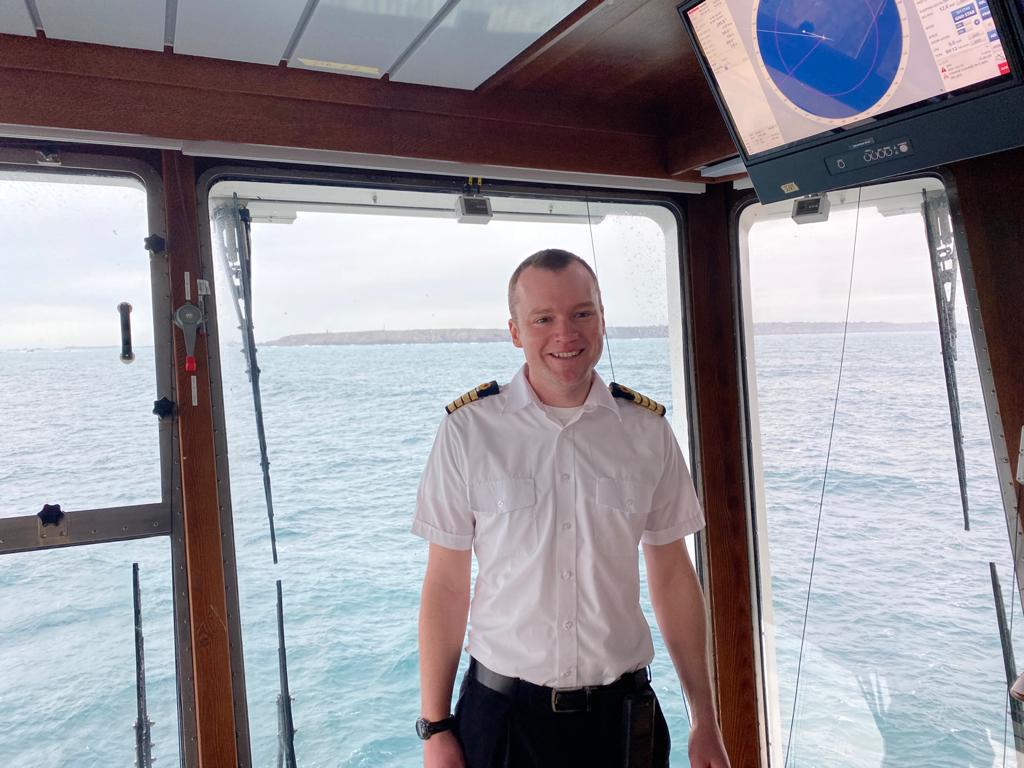Meet the crew: Captain Will Whatley
10 March, 2021 RRS Sir David Attenborough
Last month, the RRS Sir David Attenborough carried out two weeks of sea trials around the UK. We caught up with Captain Will Whatley to find out how it feels to be Master of one of the most famous ships in the world, and how you test a polar ship.

Tell us a bit about your career at British Antarctic Survey
I joined BAS in 2008 as 3rd Officer at the age of 19. Soon after joining I realised how interesting working for BAS is. Whilst there are many challenging aspects to Antarctic operations, it remains a very enjoyable place to work. Becoming Captain of RRS Sir David Attenborough is the ultimate job for me and I feel exceptionally fortunate to be in this position. My standout memory from my career so far is my first Antarctic season as Captain back in 2015 heading into the ice – incredible!
How did it feel to finally take the ship to sea after seeing the first piece of steel being laid?
Driving ships (and boats) has always been my favourite part of the job so to be able to actually start manoeuvring RRS Sir David Attenborough was an extraordinary feeling. Having been working on the project since before the keel was laid it made me reflect about how significant this milestone is and what an enormous achievement it has been to get to this stage.
How do you go about testing a ship?
This begins with preparation – all systems that are possible to test with the ship still in port are tested whilst the ship is alongside. Similarly with crew training, all the possible emergency exercises and operational training that can be completed in port are done too. Once all the in port tests and training are complete the ship will go to sea and begin with the safety critical operational tests such as anchoring then start working through all the other on board systems.
How do you decide where to take the ship for trials?
This is depends on aspect of the ship we are planning to trial on any particular day there are many factors to take into account such as water depth, distance from land and other ships but most importantly the weather!
Talk us through some of the key things you were testing and how you tested them?
Ok – some key examples…
- Man overboard manoeuvres, trying different stopping techniques to find out which the quickest way to bring the ship to a stop if someone were to fall over the side.
- Fuel consumption, trialling different engine configurations to find the most fuel efficient set up for long distances.
- Rough weather, before heading to the Southern Ocean where we are far away from help we want to know that the ship can handle some rough weather and see if there is anything that is not secure.
- Dynamic Positioning is a computer which can hold the ship in any given position and complete pre-programmed manoeuvres for us – this is used extensively for scientific deployments and needs to be tested in different weather conditions.
- The ship is fitted with an anti-rolling system to keep the motion of the ship safe and comfortable in rough weather – this was tested in all its modes of operation and in different weather conditions. The same system can also be used to force the ship to roll to reduce the chance of getting stuck in pack ice or to try and break the friction to get the ship unstuck if already beset, this was also tested.
- Emergency steering – it is possible to steer the ship locally from where the rudders enter the hull but it takes a bit of practice to be able to do it effectively. We test this when we have no ships or land near us so that if we ever had to do it due to a mechanical fault we know how to.
- Blackout recovery tests. It is very rare but if we were to loose all power for some reason we need to know what happens and how to recover from that situation, this is something we practiced in open water.
- Fresh water generation, there are two methods of generating fresh water on board SDA, reverse osmosis or evaporation, and both of these need to be tested when the ship is away from land and moving at different speeds.
How did you feel about people’s reaction to seeing the ship around the UK?
I still can’t believe how much public interest there is in RRS Sir David Attenborough and what we do. I’m delighted that the reaction to the ship is so positive and that so many people made the effort to come out and see the ship.
Did anything about the ship surprise you?
Yes – the ship handled rough weather much better than I was expecting it to – very pleasing!
What is your favourite thing about the ship?
The fact that there are so many features and capabilities within one hull is fantastic and it keeps the job really interesting.
What are you looking forward to most about taking the ship South?
Icebreaking!